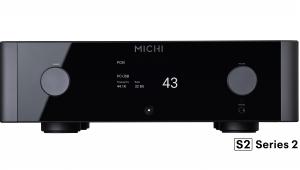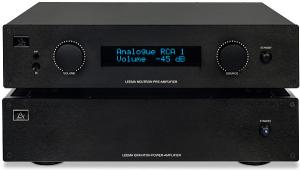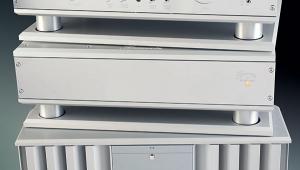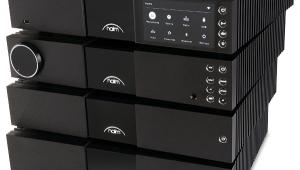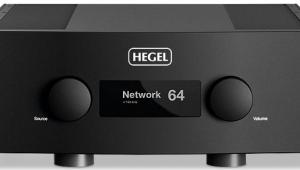Trilogy Audio Systems 909/990/968 (£3995/£5495/£3995)
Back after a hiatus of nearly a decade, Trilogy’s founder Nic Poulson has returned to amp manufacture, having spent the interim producing mains filters and regenerators. Both the promise and the standards of Trilogy ‘Mk I’ have been maintained in the rebirth, but with new twists, including microprocessor control.
Poulson has revived Trilogy with three models, continuing the 900-nomenclature of the 1990s units. The 909 preamplifier will most amuse the tweaker because it’s all-valve, using three ECC88/6922s and a 6U4P rectifier, but it boasts features usually found in cutting-edge solid-state products, or valve exotica from the likes of VTL, McIntosh and other American makers.
In the middle of the front panel are eight tiny press buttons (sadistically unlabelled) which access a host of user-adjustable options, including one function I’ve not seen elsewhere: a security system. If the 909 is switched off at the mains for more than 30 minutes, a PIN code has to be entered the next time you switch on. If the unit is stolen, you will have the mild satisfaction of knowing that the toe-rag who took it can’t use it unless he grabbed the code sheet as well.
INNER LIGHT
Other functions include custom labelling of inputs, balance trim to 0.5dB, gain trimming for each input to match the various sources, a timed system switch on via Trilogy’s proprietary TASlink, remote operation, calendar display and more. Trilogy stresses, however, that the audio performance is not compromised because all internal links to the audio boards are via QuietBuss, which uses light to transmit information, and which apparently protects the gain stage from external EMI.
Accepting six line sources, switched via relays sited ‘within millimetres’ of the rear panel connectors, the 909 also offers two separate auxiliary loops, for recorders or processors. At the rear of the preamp can be found gold-plated phonos for all the inputs and outputs, the in/out TASLink sockets and six green LEDs to monitor the unit’s behaviour.
Volume is set with a relay-switched, stepped-shunt attenuator, operating in 0.5dB steps through precision discrete resistor arrays. The volume control range can also be tailored to your tastes, because you can set its operation from 360 to 1080º for ultra-precise level setting for even the most ham-fisted.
That large knob, while operating the volume, also accesses menus, and there’s a remote control (not ready for the review) for all functions. Status is relayed to the user through a highly-legible, red dot matrix LED panel display; brightness can be set to track ambient light, which provided no end of amusement. Other fun distractions include a real-time clock to provide switch-on/off events via TASlink, nice for those who want to warm up the system before arriving home for a listen. It can be used, too, as a sleep function, powering down after a defined period.
THE POWER AMPS
Two power amps match the 909, and the nature of the preamp is such that we expect it to sell with the power amps. Yes, there may be those who will mix ’n’ match it with other makes, but for the review, we’ve assessed it with the sibling units. The 968 is all-valve, the output tube line-up in the review sample comprising three ECC88/6922s feeding two JJ-branded E34Ls per channel; KT88s are a £155 option. It’s rated at 60W/ch, with front panel selectability between triode and pentode operation. Valve veterans know what to expect: the former offers sweeter sound while the latter offers more grunt. What’s nice is being able to choose them as the mood, music or ancillaries demand.
Reflecting the cleverness of the preamp, the 968’s output tube bias adjustment is set by matching the brightness of two LEDs on the front panel. These also indicate any valve failure: the monitoring system will shut down the 968 and an LED will indicate the faulty tube’s position. Although all Trilogy models are housed in the roughly the same 424x428x99mm (wdh) nonmagnetic enclosures, it still contains massive output transformers and high parts content. Inputs are via phono, and Trilogy sourced some truly useful multi-way binding posts.
For more power, there’s the 100W/ch 990, a hybrid using a front-end like the 968’s for voltage gain, with six ECC88/6922s and a 6U4P rectifier, shunt regulated with its own transformer. In common with many hybrids, the 990 uses a MOSFET output stage, although in this instance it’s bridged.
While the all-tube 968 has a single-piece, ventilated cover, the 990 has a bold ‘spine’ running down the middle, acting as a heatsink. It’s milled from a solid aluminium billet, drilled with eight large openings which are illuminated in a blue glow, flashing to indicate standby status. The amplifier runs warm, but the heatsinks are effective, the unit never shutting down even when worked hard.
A FAMILY AFFAIR
Used over some weeks with a mix of speakers including Sonus faber Guarneri, PMC DB1+, Rogers (15ohm) LS3/5A and Tannoy Autograph Mini, the Trilogy pairings turned up some curious results, not least finding myself uncharacteristically preferring the hybrid to the all-valve. Odd little quirks manifested themselves, which might be attributed to the ‘youth’ of the review samples: they came from the first batch off the assembly line, and it’s clear that two areas need attention: hum – both mechanical and electrical – and tube/channel matching.
It was only by using a number of mono recordings from Louis Prima and Buddy Holly (by all means seek out the new rarities set, Down The Line, if you’re a fan) that I noticed a solid but slightly off-centre image. With tape measure in hand, I checked that I had not moved my chair, nor ‘mis’-positioned the speakers. Suffice it to say, you may need to access that balance-adjustment-in-0.5dB-steps menu.
But I did use the word ‘curious’, which may explain my bafflement in liking what I heard despite minor anomalies. The humming was of a low enough level in my room to be masked by the music in full flow, and I suppose that my ears ignored it in precisely the manner that vinyl junkies are immune to slight surface noise.
What emerged was a system so carefully voiced that the pre/power combination worked better than any attempts at mixing with components including Quad’s 909 power amp, or McIntosh’s C2200 or EAR’s 834L preamps. And the two amp are unmistakeably siblings, yet choosing between them is simple.
No, that isn’t a reference to the £1500 price difference, which will be a decisive factor for a many customers. Just as the 968 allows you to flick between triode and pentode, so does the 990 offer a slightly different take on what is recognisably the ‘Trilogy sound’. And that sound is undeniably a warm, lush valve midband, with distinct, controlled extremities.
Of course, the hybrid, thanks to greater power, can best the 968 for sheer punch and dynamics, but the 968 possesses an audibly superior way with subtleties. Listening to the glorious, Quincy Jones-produced tracks that Lesley Gore recorded for Mercury over 45 years ago, I was treated to massive bass with absolute control and exquisitely sharp transients – especially the percussion. Gore’s vocals, known for perfect enunciation, shimmered. The percussive break in ‘Maybe I Know’, with its acapella vocal line, acquired a sense of the dramatic that was barely conveyed through the AM radios of the day, calling for a reassessment of this singer’s artistry. Hand claps, strings – the Trilogy pairings hold it all together, while maintaining the individuality of each of the tonal flavourings.
If the Trilogy systems had no trouble whatsoever with big, orchestral pop, especially the more powerful hybrid, then the real surprise came from the opposite end of the performance spectrum. Both Seasick Steve and Son of Dave are one-man-bands with serious blues roots. The former is known for his knackered, three-string guitar, which still makes as powerful a statement as an amped-up Fender, while the latter delivers songs powered by furious harmonica work, every tune seasoned with the tang of the theme to The Sopranos: down and dirty.
Although these artists are primarily unplugged, like buskers let loose in a studio, such sparse instrumentation delivers mighty sounds, their vocals are heavily textured and their recordings possess real you-are-there authenticity. Here the choice narrowed, the 968 in pentode mode matching the 990 in all but low-end punch, especially heavy foot-stomping or the pounding on the guitar’s body. The 990 seemed quicker, too, but the family resemblance remained uncanny – more Phil and Don Everly, as it were, than Noel and Liam Gallagher.
DESIGNATED DRIVER
Both also performed differently according to the speakers: the all-valve 968 sounded best with the LS3/5As and the wee Tannoys, the 990 favouring the tough-to-drive Guarneris. One might assume that a Trilogy dealer will be able to demonstrate both amps with the speakers of one’s choice, but should that prove impossible, note that the 968 behaves like an all-valve amplifier, and the 990 provides the greater leeway of a more powerful device with solid-state output stages.
As mentioned before, that £1500 price difference is a dealbreaker for many of us. And there is still the matter of Trilogy shaking out a few bugs affecting these early samples. But the cutting-edge features all worked perfectly, nothing ever shut down or misbehaved, and I gather that eliminating the hums requires only the application of tried-and-tested solutions. In which case, should the cures be applied, I would have no hesitation in adding three percentage points to the sound scores I’ve given below.
VERDICT
Poulson has managed again to marry pure valve magic with the virtues of solid-state equipment. The clever convenience features, though, are mere bonuses, because sound quality is what matters for the high-end, for which this certainly qualifies. While these early samples show that some fine-tuning is needed, I’m still pleased to be able to say, ‘Welcome back, Nic.’
Originally published in the April 2009 issue





